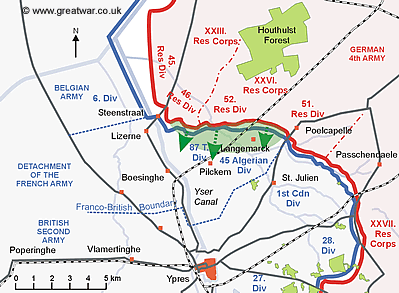 German accounts of the gas cloud
German accounts of the gas cloud
22 April 1915: 17.00
A German soldier later recalled his experience of the first effects on the French troops as the gas cloud rolled across to the French trenches:
“As this great cloud of green gray gas was forming in front of us, we suddenly heard the French yelling. In less than a minute they started with the most rifle and machine gun fire that I had ever heard. Every field artillery gun, every machine gun, every rifle that the French had, must have been firing. I had never heard such a noise. The hail of bullets going over our heads was unbelievable, but it was not stopping the gas. The wind kept moving the gas towards the French lines. We heard the cows bawling, and the horses screaming. The French kept on shooting. They couldn't possibly see what they were shooting at. In about 15 minutes the gun fire started to quit. After half an hour, only occasional shots. Then everything was quiet again.” (1)
Leutnant Richard Drach of the 238 Reserve-Infanterie-Regiment (52. Reserve Division) wrote in his account that there was firing from the enemy’s forward sentries sounding the alarm. This was followed by thunderous gunfire from the enemy artillery.(2) Leutnant Becker, in the same regiment, also described how the enemy infantry fire started up and died away:
“The enemy fired into the suffocating vapour, but soon the rifle fire died down. Heavy enemy artillery fire started up in its place. But the shells were landing behind our jumping off positions, which we had occupied in front of our front line by previously cutting lanes through the barbed wire.” (3)
With regard to the fire of the French artillery firing onto and beyond the German front line, Oberleutnant Mattenklott, II. Battalion, of the 238 Reserve-Infanterie-Regiment (52. Reserve Division) wrote that the regimental reserves and regimental headquarters were in danger from this. They were located in the Kortebeek Position, which was believed to be behind the German front line at the Kortebeek stream north of Langemarck. Oberleutnant Mattenklott wrote:
“The French artillery did not fire on us. Instead they aimed further back behind us and fired onto the Kortebeek Position. They caused more damage there than they might have suspected. Our Staff headquarters and reserves were all in this position.” (4)

In fact, the French shells killed a number of Staff officers, including the commander of the I. Battalion, 238 Reserve-Infanterie-Regiment, Major Bäumler. The I. and III. Battalion Staff headquarters were in the Dreikellerhaus, which presumably was a building near the front line. The German name literally translates as ‘The House with Three Cellars’:
“There was a direct hit onto the ‘Dreikellerhaus’, which was the location of the regimental and III. Battalion forward headquarters for the attack. Major Mayer, Major Bäumler, Oberleutnant von Pfeill and several other soldiers serving on the headquarters Staff were killed.” (5)
Next>> Gas cloud rolls through the French trenches
Acknowledgements
(1) Source: Dokumentatiecentrum Dr. A. Caenepeel, In Flanders Fields Museum, Ieper, Belgium
(2) Geschichte des Reserve-Infanterie-Regiments Nr. 238, p. 58
(3) Geschichte des Reserve-Infanterie-Regiments Nr. 238, pp. 56-58
(4) Geschichte des Reserve-Infanterie-Regiments Nr. 238
(5) Geschichte des Reserve-Infanterie-Regiments Nr. 238, p. 55
(6) Photo courtesy of the WW1 Image Archive